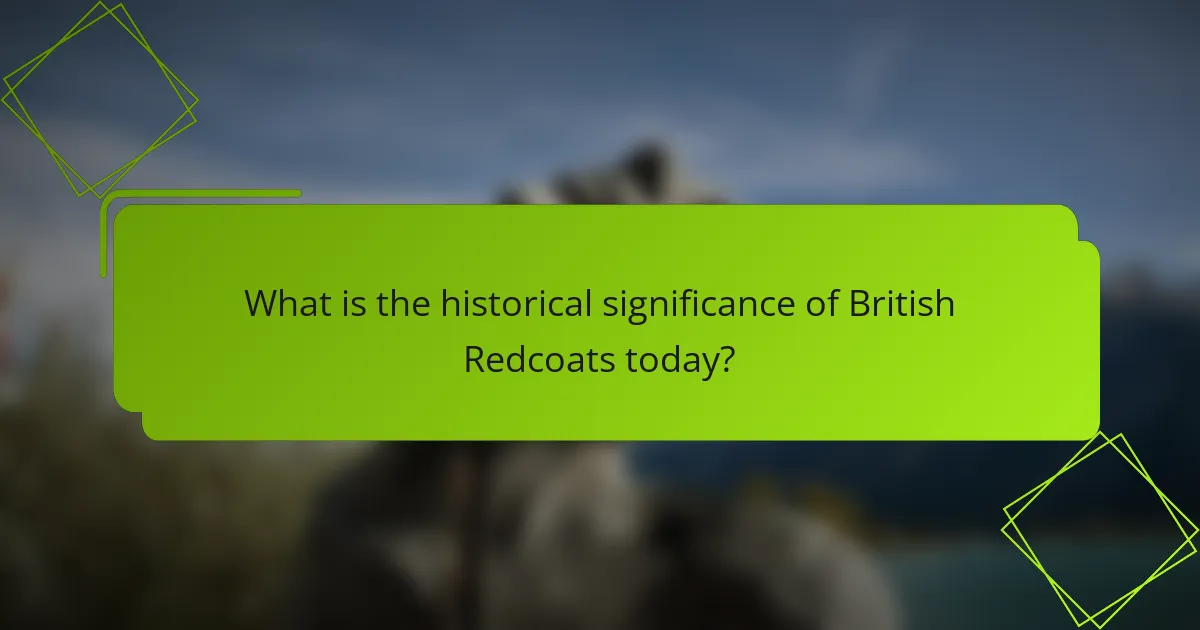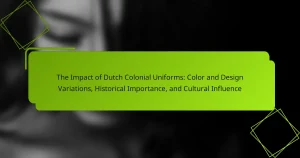The British Redcoats were soldiers of the British Army known for their iconic red uniforms, which emerged in the late 17th century and became prominent during the 18th and early 19th centuries. This article examines the evolution of British Redcoats, highlighting their key features, historical significance, and regional variations. It discusses their crucial role in major conflicts such as the American Revolutionary War and the Napoleonic Wars, as well as the adaptations of their uniforms based on local customs and environmental conditions. The article also explores the enduring legacy of the Redcoats in representing British military heritage and their influence on modern military practices.

What are the British Redcoats and their historical context?
The British Redcoats were soldiers of the British Army, primarily recognized for their distinctive red uniforms. They emerged during the late 17th century and became prominent in the 18th and early 19th centuries. The term “Redcoat” reflects the color of their uniform, which was practical for military visibility. Historically, these soldiers played a crucial role in various conflicts, including the American Revolutionary War and the Napoleonic Wars. Their presence symbolized British military power and colonial expansion. The red uniform was chosen for its psychological effect on both soldiers and enemies. The Redcoats were known for their disciplined formations and tactics, which contributed to their effectiveness in battle. The historical context includes the British Empire’s need for a professional army to maintain control over its colonies.
How did the British Redcoats come to symbolize the British Army?
The British Redcoats symbolize the British Army due to their distinctive red uniforms and historical significance. These uniforms were first adopted in the 17th century. The color red was chosen for its visibility and intimidation factor in battle. Redcoats became a common sight during the 18th and 19th centuries. They were associated with British military campaigns, particularly during the American Revolutionary War. The term “Redcoat” became synonymous with British soldiers. This association was reinforced through literature and media. The iconic red uniform remains a symbol of British military heritage today.
What were the origins of the British Redcoat uniform?
The British Redcoat uniform originated in the 17th century. It was initially adopted by the English army in the 1640s. The bright red color was chosen for its visibility on the battlefield. Red dye was readily available and less expensive than other colors. The uniform became standardized during the late 17th century. By the 18th century, it symbolized British military identity. The Redcoat was worn by regular infantry and became iconic during the colonial period. Its design evolved over time, incorporating various features for functionality and style.
How did the design of the Redcoat evolve over time?
The design of the Redcoat evolved significantly from the 17th to the 19th century. Initially, Redcoats featured simple designs with limited embellishments. By the late 18th century, the cut became more tailored, with the introduction of lapels and cuffs. The fabric transitioned from wool to a mix of wool and cotton for durability. In the early 19th century, the introduction of epaulettes and intricate insignias marked a shift towards a more formal military appearance. The color red remained constant, symbolizing British military identity. The evolution reflected changes in military tactics and social perceptions of the army. Historical records indicate that these changes were influenced by both practical needs and evolving fashion trends.
What were the key features of the British Redcoat uniform?
The key features of the British Redcoat uniform included a distinctive red coat, white facings, and a black leather belt. The red color symbolized the British military and provided visibility on the battlefield. The coat was typically made of wool and featured a high collar and cuffs. White facings indicated the regiment and added contrast to the red. The uniform also included a tricorn hat or a bearskin cap, depending on the period. Soldiers wore trousers or breeches, often in white or buff colors. These features were designed for both function and identification in military engagements. The uniform evolved over time, reflecting changes in military tactics and fashion.
What materials were commonly used in the construction of Redcoats?
Redcoats were commonly constructed using wool and cotton. Wool was the primary fabric, providing warmth and durability. Cotton was often used for linings and lighter garments. Leather was utilized for accessories like belts and boots. These materials were chosen for their availability and functionality. Historical records indicate that the red dye used for the coats was derived from madder plants. This dye made the coats recognizable and symbolized British military identity.
How did the color and insignia of Redcoats vary by regiment?
The color and insignia of Redcoats varied significantly by regiment. Each regiment had its own distinct color scheme and insignia to differentiate itself from others. For instance, the 1st Foot Guards wore red coats with a white plume, while the 2nd Foot Guards had a blue plume. The 33rd Regiment of Foot was known for its distinctive yellow facings. Additionally, regiments often displayed unique symbols or badges on their uniforms. These variations helped in identifying regiments during battle and parades. Historical records indicate that these differences were crucial for both organizational and ceremonial purposes.
What role did British Redcoats play in historical conflicts?
British Redcoats served as the primary infantry of the British Army during various historical conflicts. They were instrumental in wars such as the American Revolutionary War and the Napoleonic Wars. The Redcoats were known for their distinctive red uniforms, which became a symbol of British military might. Their role included engaging in direct combat, maintaining discipline, and executing military strategies. The effectiveness of Redcoats was evident in their use of linear tactics, which maximized firepower. Historical records show that they played a crucial role in key battles like the Battle of Bunker Hill and the Battle of Waterloo. Their presence often influenced the morale of both allies and enemies. The Redcoats’ legacy continues to impact military traditions today.
How did British Redcoats influence military tactics during their era?
British Redcoats significantly influenced military tactics during their era by introducing linear formations and disciplined firepower. Their emphasis on organized ranks allowed for more effective volleys against enemies. This tactic increased fire efficiency and reduced chaos in battle. The Redcoats also utilized rapid maneuvering to outflank opponents. Their training emphasized discipline and coordination among soldiers. This led to improved battlefield communication and strategy. Additionally, their use of light infantry tactics began to evolve, allowing for greater flexibility in combat. The success of these tactics was evident in numerous conflicts, including the Seven Years’ War.
What significant battles featured British Redcoats prominently?
The significant battles that featured British Redcoats prominently include the Battle of Bunker Hill, the Battle of Saratoga, and the Battle of Waterloo. At the Battle of Bunker Hill in 1775, British Redcoats faced colonial forces during the early stages of the American Revolutionary War. The Battle of Saratoga in 1777 marked a turning point in the war, showcasing British Redcoat strategies against American forces. The Battle of Waterloo in 1815 saw British Redcoats play a crucial role in defeating Napoleon’s army. These battles highlight the strategic importance of British Redcoats in key historical conflicts.

What are the regional variations of British Redcoats?
British Redcoats exhibited regional variations based on local customs and military needs. In Scotland, the Highland regiments incorporated tartan patterns into their uniforms. This adaptation reflected local heritage and identity. In Ireland, regiments often wore green uniforms, distinguishing them from English counterparts. The West Indies regiments utilized lighter fabrics due to the tropical climate. These variations were practical responses to environmental conditions and cultural influences. Historical records indicate that these adaptations helped maintain troop morale and local support. The diversity in uniforms illustrates the British Army’s ability to integrate regional characteristics while maintaining a unified command structure.
How did British Redcoats differ across various regions?
British Redcoats differed across various regions primarily in their uniforms, tactics, and roles. In North America, Redcoats often wore lighter uniforms suited for the climate and terrain. Conversely, in Europe, they typically donned heavier woolen uniforms for colder conditions. Regional variations also included the use of different insignia and decorations, reflecting local regimental traditions. Tactics varied as well; in the Americas, they employed guerrilla warfare techniques to adapt to the landscape. In contrast, European engagements favored traditional linear formations. The deployment of Redcoats also differed; in colonies, they often acted as peacekeepers and law enforcers. In Europe, their role was primarily as combat soldiers in large-scale battles. These distinctions were influenced by the specific challenges and environments faced in each region.
What unique features characterized Scottish Redcoats?
Scottish Redcoats were characterized by their distinctive tartan patterns and unique headgear. The tartan was often specific to the regiment or region, showcasing Scottish heritage. They typically wore a feather bonnet as part of their uniform, which set them apart from other British soldiers. Additionally, Scottish Redcoats often carried claymore swords, a traditional Scottish weapon. Their uniforms also featured a distinctive cut and design that reflected both military functionality and Scottish culture. These unique features contributed to their identity and representation in the British Army during various historical conflicts.
How did the uniforms of Irish Redcoats compare to their English counterparts?
Irish Redcoats wore uniforms that were similar in style but distinct in color and insignia compared to English counterparts. Both groups typically wore a red coat, but Irish Redcoats often featured green or blue facings. The cut and design of the uniforms were largely consistent, reflecting British military standards. However, the Irish units sometimes incorporated local elements and variations in accessories. Historical records indicate that these differences were influenced by regional pride and identity. The Irish Redcoats also had unique regimental insignia that distinguished them from English troops. These distinctions were significant during the 18th and 19th centuries, particularly in the context of Irish nationalism. Overall, while the core design remained aligned with British military aesthetics, Irish Redcoats showcased regional adaptations.
What influences shaped the regional variations of British Redcoats?
Regional variations of British Redcoats were influenced by local geography, climate, and military needs. Different regions required adaptations to the standard uniform for practicality. For instance, the terrain in North America led to variations in fabric and color. The humid climate influenced the choice of lighter materials in warmer areas. Local military engagements also dictated modifications for camouflage and functionality. Historical conflicts shaped the design and use of Redcoats in various regions. The need for adaptability resulted in distinct regional characteristics that reflected local conditions and warfare strategies.
How did local climates affect the design and materials of Redcoats?
Local climates significantly influenced the design and materials of Redcoats. In colder regions, thicker wool fabrics were used for insulation. This ensured warmth during harsh winters. Conversely, in warmer climates, lighter materials like cotton were preferred. These fabrics allowed for better breathability and comfort. The color of the uniforms also varied based on climate. Darker colors absorbed heat, while lighter shades reflected sunlight. Additionally, local availability of materials dictated uniform construction. Regions rich in wool produced heavier garments, while those with abundant cotton favored lighter designs. Historical records show these adaptations were crucial for soldier comfort and effectiveness in diverse environments.
What cultural factors contributed to differences in Redcoat uniforms?
Cultural factors significantly influenced differences in Redcoat uniforms. The British military adopted various styles to reflect regional identities. Local customs and traditions shaped uniform designs in different colonies. For example, uniforms in North America featured adaptations suited for local climates and terrains. Additionally, influences from indigenous cultures were integrated into some designs. The social hierarchy of British society also played a role in uniform variations. Higher-ranking officers often wore more elaborate designs than lower ranks. Historical events, such as conflicts and alliances, further impacted uniform evolution. Each of these cultural factors contributed to the distinctiveness of Redcoat uniforms across regions.

What is the historical significance of British Redcoats today?
The historical significance of British Redcoats today lies in their representation of British military heritage. They symbolize the British Army’s role in major conflicts, particularly during the 17th to 19th centuries. The Redcoats were pivotal in the American Revolutionary War, showcasing British military strategies and discipline. Their distinctive red uniforms have become iconic, representing British colonial power. Today, they are often featured in historical reenactments and cultural events. This enduring presence highlights the Redcoats’ impact on national identity and military tradition. The legacy of the British Redcoats continues to influence modern military uniforms and ceremonial practices.
How are British Redcoats remembered in modern culture?
British Redcoats are remembered in modern culture primarily through their portrayal in films, literature, and historical reenactments. They symbolize British military history, particularly during the 18th century. Their distinctive red uniforms are iconic and often associated with the American Revolutionary War. Many historical novels and movies depict Redcoats as both heroes and villains, reflecting differing perspectives on colonialism. Museums and historical sites frequently feature exhibits on British Redcoats, showcasing their role in significant battles. Additionally, they are commemorated in parades and events that celebrate military heritage. This cultural memory contributes to an ongoing interest in British history and military traditions.
What role do British Redcoats play in historical reenactments?
British Redcoats serve as a representation of British soldiers from the 17th to the 19th centuries in historical reenactments. They recreate the uniforms, tactics, and lifestyle of these soldiers to educate the public. These reenactments often depict significant battles or events from British history. Participants aim to provide an immersive experience for audiences. The portrayal of Redcoats includes accurate details about their attire and weaponry. Historical accuracy is a key component of these reenactments. Events may include drills, skirmishes, and demonstrations of military life. This helps preserve and promote interest in British military history.
How do museums and educational programs preserve the legacy of Redcoats?
Museums and educational programs preserve the legacy of Redcoats through curated exhibits and interactive learning. They display authentic uniforms, weapons, and artifacts to provide historical context. Educational programs include workshops and reenactments that engage visitors. These initiatives help convey the experiences of soldiers and their roles in history. Museums often collaborate with historians to ensure accuracy in their presentations. They also offer lectures and guided tours to deepen understanding. By utilizing multimedia resources, they enhance visitor engagement and retention of information. This comprehensive approach ensures the legacy of Redcoats is effectively communicated to future generations.
What lessons can be learned from the evolution of British Redcoats?
The evolution of British Redcoats teaches valuable lessons about military adaptation and identity. Firstly, the Redcoats adapted their tactics and uniforms to meet changing warfare demands. For example, during the 18th century, they transitioned from bright red coats to more subdued colors for camouflage. This change reflected the need for stealth in battle. Secondly, the Redcoats symbolize national identity and unity. Their distinctive uniforms fostered a sense of belonging among soldiers. This was particularly evident during the American Revolutionary War, where Redcoats represented British authority. Lastly, the evolution highlights the importance of logistical support. The British Army improved supply chains to maintain troop effectiveness. Historical records show that these adaptations contributed to their military successes and failures. Overall, the evolution of British Redcoats underscores the need for continuous improvement in military strategies and practices.
How can the study of British Redcoats inform our understanding of military history?
The study of British Redcoats provides insights into military history through their role in various conflicts. British Redcoats were emblematic of the British Army from the 17th to the 19th centuries. Their uniforms and tactics reflected military evolution during this period. The Redcoats participated in key historical events, including the American Revolutionary War and the Napoleonic Wars. Their strategies influenced modern military practices. The Redcoats’ discipline and training set standards for future armies. Additionally, their presence in colonies shaped military engagements worldwide. Understanding their impact aids in analyzing the development of military organizations.
What best practices can be derived from the design and adaptation of Redcoat uniforms?
Best practices derived from the design and adaptation of Redcoat uniforms include prioritizing functionality and visibility. The Redcoat uniform was designed to be easily recognizable on the battlefield. This visibility fostered unit cohesion and morale among soldiers. Additionally, the use of durable fabrics ensured longevity and resilience in various conditions. Adaptations over time reflected practical needs, such as weather resistance and ease of movement. Historical context shows that these uniforms evolved based on feedback from soldiers and battlefield experiences. The integration of distinctive colors helped in identifying units quickly during engagements. Overall, these practices emphasize the importance of adaptability and practicality in military uniform design.
The British Redcoats were soldiers of the British Army, recognized for their distinctive red uniforms, which emerged in the late 17th century and became prominent through the 18th and early 19th centuries. This article explores the historical significance of the Redcoats, their role in major conflicts such as the American Revolutionary War and the Napoleonic Wars, and the evolution of their uniforms, including key features like color and insignia variations by regiment. Additionally, it discusses regional adaptations influenced by local climates and cultures, as well as the Redcoats’ legacy in modern military traditions and cultural memory.




